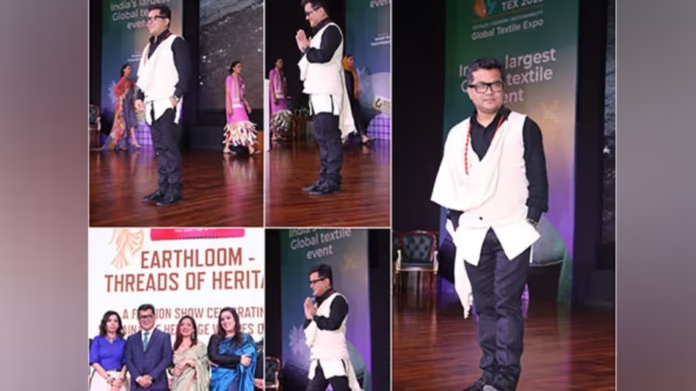In a spectacular moment at Bharat Tex 2025, Union Minister of State for Textiles, Pabitra Margherita, turned heads as the showstopper for Meghalaya-based designer Daniel Syiem, representing India’s rich sustainable textile heritage. The four-day event, held at Bharat Mandapam in New Delhi, celebrated the nation’s textiles industry, with a special focus on sustainability, circularity, and digitization in textile manufacturing.
Margherita, who has a background in textiles before his political career, proudly donned an Eri silk shawl and waistcoat during the fashion sequence titled ‘Earthloom – Threads of Heritage.’ This sequence, curated by the talented designer Daniel Syiem, highlighted the beauty and timeless appeal of India’s indigenous textiles. The choice of Eri silk, a fabric deeply connected to the culture of Northeast India, resonated deeply with the audience, as it showcased the intricate craftsmanship and sustainable production methods of the region’s weavers.
In a heartfelt post on X (formerly Twitter), Margherita shared his pride, saying, “It was indeed a proud moment to wear our identity, the Eri silk, at the show and present it to a diverse audience.” His words echoed the importance of representing the traditional textiles of the region on such a prominent global stage.
Margherita’s participation in the show was not just about the fashion; it was about honoring the artisans and the weaving communities that have kept India’s heritage alive for centuries. Reflecting on the experience, he said, “Strutting down the runway reminded me of my younger days, only this time, the spotlight was on our weavers and designers and their timeless creations.” His presence at the event highlighted the importance of promoting indigenous and tribal textiles, an initiative Margherita has been championing throughout his political career.
Bharat Tex 2025, which took place from February 14 to 17, was a gathering of global industry leaders, policymakers, and buyers. It was organized by the Aalekh Foundation and the Confederation of Indian Textile Industry. The event included exhibitions, knowledge sessions, and interactive pavilions that centered on key themes such as sustainability, circularity, and the digitization of the textile sector. The showcase also featured fabric testing zones, product demonstrations, and masterclasses by craft experts, giving participants a firsthand understanding of the innovative and sustainable practices shaping the future of textile manufacturing.
One of the most major highlights of the event was the focus on sustainable textile practices and eco-friendly innovations. Bharat Tex 2025 built on the success of its inaugural edition, positioning India as a leader in sustainable textile manufacturing within the global value chain. The event provided a platform for India’s rich heritage of textiles, such as the Eri silk worn by Margherita, to be recognized and celebrated on the world stage.
The Eri silk, specifically sourced from Northeast India, has long been associated with sustainable practices. The silk is produced through a non-violent method, where the caterpillar is allowed to complete its life cycle before being harvested, making it an ethical alternative to conventional silks. By wearing Eri silk at Bharat Tex 2025, Pabitra Margherita not only showcased India’s commitment to sustainability but also highlighted the importance of preserving the environment and supporting local communities involved in traditional weaving practices.
As the textile industry continues to evolve, the focus on sustainability and ethical production methods becomes increasingly important. Bharat Tex 2025 provided a major opportunity for India to take the lead in global textile discussions, positioning the country as a hub for innovative, sustainable, and ethical textile manufacturing. The event also allowed designers like Daniel Syiem to showcase their creativity while advocating for responsible production processes, which benefit both the environment and the artisans who create these unique fabrics.
Pabitra Margherita’s runway appearance at Bharat Tex 2025 was more than just a fashion statement. It was a tribute to India’s rich textile heritage, a celebration of sustainable practices, and a call to support the artisans who continue to preserve these age-old traditions. As the textile industry looks to the future, events like Bharat Tex 2025 pave the way for India to emerge as a global leader in sustainable textile production, making it a proud moment for all involved.




